An arctic blast will bring dangerously cold temperatures to the northern and midwestern states as the temperatures are expected to plummet.
More than 20 million people in a zone of as many as 15 states, spanning from Idaho to Michigan, may even face below-zero temperatures.
Temperatures are forecast to be 30F to 40F degrees lower than average today, Monday, and Tuesday morning.
The National Weather Service warned people about the cold arctic front that will affect the country at the start of this week. The conditions are a result of an interaction between an arctic air mass and moisture, meteorologists said.
In a wind chill advisory, the service said that a "prolonged and potentially significant" icing event is expected, in an area from the southern Plains to the Tennessee Valley.

Frigid temperatures will develop over the central and western US while heavy rain and scattered flash floods are possible across eastern Texas and the lower Mississippi Valley on Wednesday.
The cold blast will significantly affect the traffic network, causing treacherous travel conditions, as a zone of freezing rain and drizzle along with some sleet is very likely from parts of Texas to the Ohio and Tennessee Valleys.
Further west, heavy rain and flooding are forecast for a large portion of the Hawaiian Islands on Monday.

Heavy snowfalls is also possible over the high terrain of western Colorado, as well as the southern California mountains, making travel difficult at times.
Farther east, lake effect snow is likely downwind of the Great Lakes, with the heaviest amounts of over 6 inches possible off Lake Superior and Lake Erie.
Areas in Texas and the mid-South including Dallas and Austin are at risk of power outages due to the severe weather, Fox Weather reported.

The dangerous chilling blast comes as the country still tries to recover from severe deadly floods and snowfalls.
Millions of Americans were subjected to freezing temperatures in December as a 'bomb cyclone' storm in Michigan left at least 17 dead.
A town named Hell was reported as having frozen over, while 1.5 million people in the country were forced to go without power just before Christmas.
The Winter Storm Elliot mostly targeted the east coast, with the states of Maine, Pennsylvania, Virginia, and North Carolina the worst affected by the power outages.

Rockfalls and landslides shut down roads, and gushing runoff turned sections of freeways into waterways at the start of the year in California.
The deadly California storms dumped more than a 1ft 6ins (45cm) of rain in Southern California mountains and buried Sierra Nevada ski resorts in more than 5ft (1.5m) of snow.
Swollen rivers swamped homes and residents of small communities inundated with water and mud were stranded.
Over the last eight years, Texas has experienced the most weather-related deaths in the United States. From 2014 through 2021, 615 people have died and an additional 1,453 have been injured in Texas from weather events.
Floods and winter weather, including extreme cold, are responsible for the most weather-related deaths in Texas, according to the National Safety Council.







